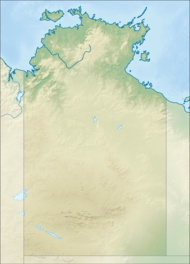Nourlangie Rock
|
Nourlangie Rock Northern Territory |
|
|---|---|
|
IUCN category II (national park)
|
|

Nourlangie Rock
|
|
| Nearest town or city | Jabiru |
| Coordinates | 12°51′42″S 132°48′45″E / 12.86167°S 132.81250°ECoordinates: 12°51′42″S 132°48′45″E / 12.86167°S 132.81250°E |
| Website | Nourlangie Rock |
| See also | Protected areas of the Northern Territory |
Burrunggui (also known as Nourlangie Rock)
Burrunggui (sometimes spelled Burrunguy, previously called Nourlangie Rock) is located in an outlying sandstone formation of the Arnhem Land Escarpment within the Kakadu National Park which is in the Northern Territory of Australia. It is the traditional Country of the Gun-djeihmi speaking people and according to Traditional Owners, was shaped by Ancestral beings in the creation period of the Dreaming (Chaloupka 1982 p. 6). It was included on the World Heriatage Register. Kakadu National Park is included on UNESCO the World Heritage List due to its exceptional natural and cultural values.
Europeans were first in the area of Noulangie Rock in about 1845, after Ludwig Leichhardt’s explorations passed through the area. By the 1880s, European buffalo and buffalo shooters had moved in to the area, ad local Traditional Owners joined their shooting parties. Traditional owners told the buffalo shooters about the Dreaming stories at Burrungui and the many names of all the natural features of the landscapes. Chaloupka argues that the Europeans couldn’t remember all of the names, and called ‘Nourlangie’, a confused pronunciation of the name of the area generally called ‘Nawulandja’.
There are a number of shelters in amongst this large outcrop. The shelters contain amazing paintings that represent the Aboriginal Dreaming, with depictions of Namandi spirits, both male and female figures and one with six fingers on each hand. Many paintings in the Burrungui area also depict European items and introduced animals. Pigments are mostly of yellow, white and red ochre, with red ochre being used as a chalk to draw on the rock surface in some places. Early art at the site is evidenced in handprints on the rock in red pigment, or gars being flung on the rock. The paintings at Burrungui are in the Mimi and x-ray style, with Mimi being older and representative of Dreaming Ancestral beings. There are even depictions of Thylacines (Tasmanian Tigers), known to have been extinct in the area for at least 3,500 years. Superimpositioning of many animals such as kangaroos layered over one another, assist in the establishment of a temporal sequence at the site, however there appears to still be much research and work needed at the site for this to occur.
The rock art faces many threats to its survival, including tourists and destruction from natural processes such as ant trail that go across the older panels at Burrungui, water damage and wasp nesting. Interpretive signage is present at the art sites to assist visitors in understanding these rock art treasures and the importance of their preservation.
...
Wikipedia

